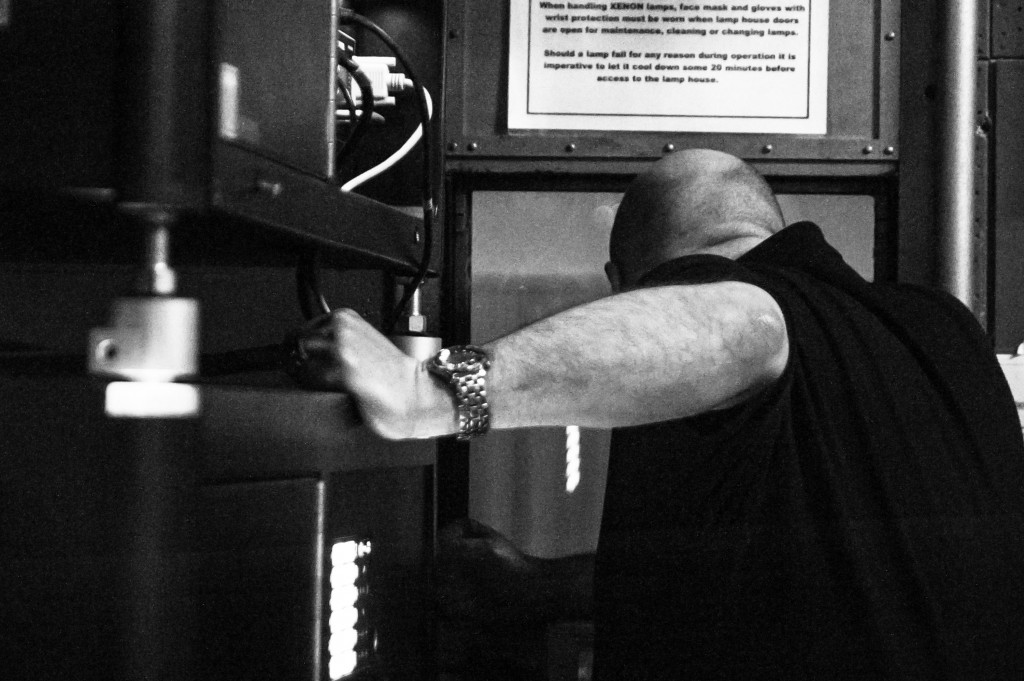DIGITAL cinema projection made its debut in Britain with the release of Toy Story 2 in 2000. It went on to dominate cinemas making hundreds of projectionists redundant. Emily Murray met Dave Norris, a projectionist who is keeping the spirit of his industry very much alive.
In 2014, an independent British horror film made its premiere at London’s FrightFest Film Festival.
In The Last Showing, Robert Englund plays a projectionist who is resigned to shovelling popcorn after refusing to learn the new digital technology that replaced 35mm film.
The disgruntled worker reacts by torturing the cinema’s manager and audience members.
Of course, the torture element is fictional but as long-serving projectionist Dave Norris tells me much of the film’s premise is not far from the truth.
In 1980, at the age of 17, straight out of school, Norris took on his first ever full time job.
“Flicking through the paper right at the bottom of the job adverts was this one line advert that just said ‘trainee projectionist required at the Odeon Leicester Square’.
“I thought oh, I had been going there since I was a kid and so I phoned the number and got interviewed by the chief projectionist.”
A week later Norris, now 53, got a call offering him the job.
“They said you are the only one actually interested in film as a technical thing.
“For everyone else applying it could have been anything; changing tyres or working in a McDonalds.”
But even before he took on his first job, Norris had already been putting on shows as a projectionist.
At the age of five his parents brought him a Standard 8 projector and an 8mm copy of a colour Mickey Mouse cartoon, 1937’s Hawaiian Holiday.
Norris then started to run 16mm shows at school charging people ten pence to go which covered the cost of the hire of the film.
It was clear that Norris was destined for the trainee projectionist job at the Odeon.
“That was the start of it really. The first thing that they said is that after training I will be moved to another cinema but someone left and so they made me a projectionist.
“Another year later a senior projectionist left and so I took on that role.
“It was almost dead man’s shoes.”
For 25 years, Norris worked at the Odeon before moving across the road to The Empire in Leicester Square.
After working in the West End as a projectionist for more than 30 years, Norris left to take charge of the screening rooms at the London headquarters of Universal Pictures in 2012.
A long career as a projectionist in the West End meant that Norris screened many premieres meaning it is hard for him to pick his favourite showings.
“Doing 10 Bond premieres was an ongoing highlight.
“There are probably not many projectionists still around who have done that many Bonds.
“My first one was For Your Eyes Only in 1981 and my last was Quantum of Solace in 2008.
“I am a big fan of Bond films as I grew up watching them and they were a part of my cinema education.
“10 years later, I was working them!”
Norris also told me that the 25 Royal film performances he worked on at the Odeon are also highlights from his lengthy career.
“I must have done thousands of premieres and although the royal performances were just another show, they are something that I am proud of.”

Having worked in the industry for three decades, Norris certainly witnessed many changes.
“The role of projectionists has constantly changed and they will always have to adapt to new technology.
“Of course now we have had the biggest change since sound came in as, except in a very few cases, there is no film anymore.”
The rise of digital cinema projection changed everything for projectionists.
In 2000 the release of Pixar’s Toy Story 2 brought the first digital cinema projector to Britain sparking a new trend.
A decade later around 80 per cent of all UK releases were digital prints and today you will rarely come across film.
With digital projection came redundancies as projectionists were replaced by automated projection.
In February 2012, Odeon confirmed that 120 of their projectionists had seen their jobs cut whilst the other 250 had been moved to different roles.
This was a move that was copied by other British cinema chains.
Norris explained to me that many of the projectionists he worked with struggled to adapt to and accept digital projection
“A lot of the people I started working with would not recognise the job anymore.
“It is very IT based now, the cinema server is basically a computer.
“I have gone along with the changes but a lot of people didn’t.
“When digital was first introduced many were unsure but I said to them you can’t stick your head in the sand, you have to go along with the new technology.
“A lot decided to leave or take redundancy though because they refused to shovel popcorn.”
Cinema chains now mostly do not hire projectionists but instead train their staff on the automated systems.
Norris says though that this leads to many problems.
“The staff are shown how to set it up but what do they do when something goes wrong, for instance when the film is in the wrong ratio or is out of focus?
“There is a serious gap in their education and training and I hear horror stories about cinemas and untrained people ringing up engineers who then drive miles to find out that the worker forgot to switch the mains on.”
The change in staffing also affects the film studios too.
“Sometimes screens have to be shut down for days because they don’t know what the problem is and so not only do the cinemas lose money but so do the studios who haven’t got a film showing.”
Norris emphasises though that the loss of showmanship, the element projectionists brought to cinemas, is the most important change that digital projection caused.
“There is a fine line between operating a server and putting a show on and that is what is missing; any sort of showmanship.”
However, Norris tells me that some cinemas have handled the change well and adapted their staff effectively.
“There is a cinema in Truro, The Plaza, which has two managers and two projectionists.
“The managers have learnt how to work the projection room and the projectionists have learnt management duties such as how to manage the box office and the tills.
“For any problems too technical the managers can ring the chief projectionist and vice versa.
“There is a nice balance going on and this is an example of it working but it is not always the case.”
When I asked Norris what he thinks the future is for projectionists his response is surprisingly hopeful.
“There will always be a place for trained people who know what they are doing.

“You may not be called a projectionist anymore but there is room for people who can put on a decent show and know what to do when there is a problem.
“I have no mythical insight really into what is going to happen and I can only say what should happen and there should be someone who knows what they are doing in cinemas.
“Fixing a fault when necessary is more important than ever now as there are a different set of problems and more than ever can go wrong.”
So although Norris is known to the world as ‘The Last Projectionist Standing’, a nickname popularised by BBC’s film critic Mark Kermode, it seems like he will not be the last one.
Even though at the time it appeared he might be.
“When the change was going on a lot of cinemas offered their projectionists redundancy.
“A lot of them were older than me so took it.
“Before though the only time anybody left was if they retired or died.
“So it was strange that in such a short space of time I was attending about a dozen leaving dos.
“At one of these a projectionist told me that I was the only one left; the only one left in the West End, the last projectionist standing.”
When Norris told his friend Kermode about this conversation the critic then credited him in his book, ‘The Good, the Bad and the Multiplex’, with the nickname.
“Mark grabbed hold of it with both hands and it has stuck a bit.
“I do think that the profession should be represented though.
“I will always go on banging the drum, on Twitter and in public.
“What projectionists do is an art form and one that is sadly being lost.”
By Emily Murray
@EmilyVMurray















Recent Comments